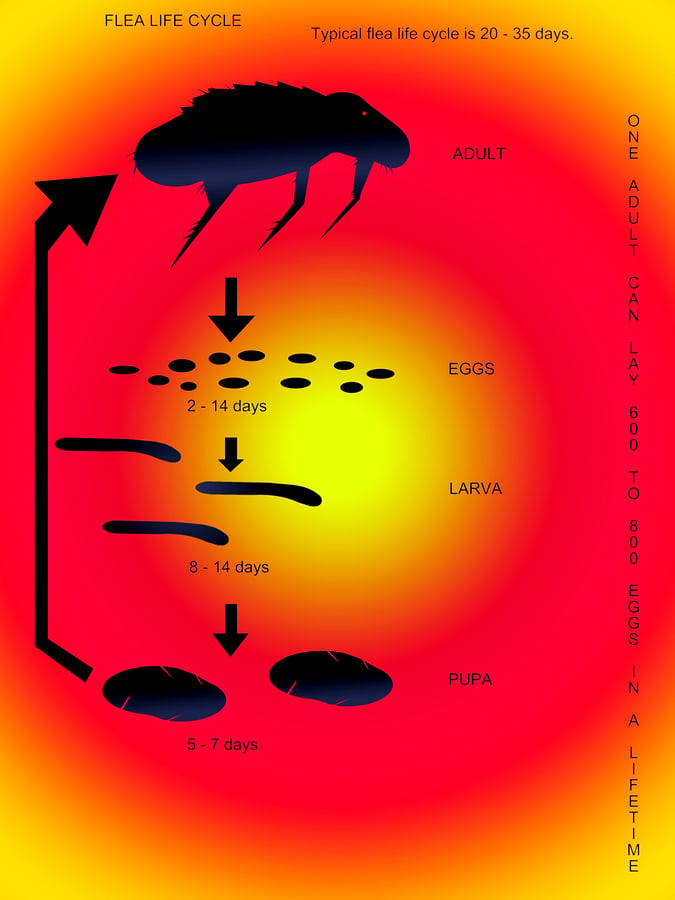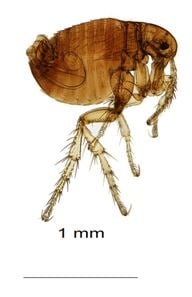April 19th, 2013 by
Among the unwanted pests that infest our pets and our houses are fleas. These small bloodthirsty insects are jumping and stinging. Vigilance and prevention are key when getting rid of fleas! HSDonline is going to look at the following topics:
 Ouch! That Itches !!!
Ouch! That Itches !!!
1) Your animal: getting rid of fleas?
If you manage to perceive " tiny black insects " cavorting cheerfully on the skin of your animal, and if its coat contains small brown dandruff, it is more than likely that your friend is living with a parasite called: a flea. There are several species of fleas which target the animal of their preference. Attention, adult dog and cat fleas do not live on humans, but they can still prick you while waiting to find their usual hosts. A flea bite on your dog or cat can be dangerous if not treated.
2) Flea life cycle
The female and male flea pricks your dog and cat, feeds on their blood, and emits "flea droppings" which fall on the ground and are going to serve as food for their larvae. Generally, only the grown-up fleas live on the animal. Eggs and larvae laid by females develop in the environment (E.g.: house carpets), and wait for the passage of our faithful companions to infest them. Most of the grown-up fleas can live for a year on the animal but if they are dislodged from their hosts, they have to find a new victim within 48 hours on pain of death.
The following picture summarises perfectly the life cycle of a flea:
 Life cycle of a flea... Here is a good tip when getting rid of fleas: these insects are not tolerant to the cold. We thus find more infestations in spring and in summer so you should keep a close eye on your dogs or cats when it's warm, fleas can develop all year long!
Life cycle of a flea... Here is a good tip when getting rid of fleas: these insects are not tolerant to the cold. We thus find more infestations in spring and in summer so you should keep a close eye on your dogs or cats when it's warm, fleas can develop all year long!
3) Diseases, prevention and flea treatment
The sting and the saliva of fleas are very irritating, and they can cause itches or even lead to an allergic reaction. Besides, if the animal scratches itself, it risks making it worse.  Size of a flea A secondary infection by bacteria can then arise. The stings on the skin can be situated anywhere on the domestic animal's body but the most typical location is the base of the tail and the back. The flea is capable of passing on pathogenic agents. One of the most frequent is a worm called dipylidium caninum. This infection is injected into the animal by the flea. To avoid this contamination, it is important to treat every animal infested by fleas against worms. Finally, the massive infestations by fleas can lead to anaemia, because of the big quantity of blood ingested by the adult fleas. Effectively getting rid of fleas, it is not only essential to treat all the dogs and the cats living under your roof, but you should not forget to eradicate the larvae and fleas which are hiding in your house and constitute a significant source of parasites. HSDonline can provide a full range of flea control products in order to eradicate these crawling insects and getting rid of fleas from your home. It is nevertheless necessary to be attentive to the fact that pesticides products kill hatched fleas but nothing will kill the eggs. That’s why our pest control experts recommend you re-treat your home after 7 days to kill newly-hatched larvae and prevent re-infestation. Most of the products that HSDonline sell can also be used when the animal has no fleas, they can be used as a prevention. Finally, to clean up your house, Hygiene Supplies Direct can provide efficient and cheap flea sprays and also flea powders or even effective smoke bombs at low prices. -No need to pay a professional pest controller when you can do it yourself. Think of all the places your dog or cat might have been: hidden places, armchairs, baskets, seats and even the boot of the car. Tell us about your flea experience, leave a comment!
Size of a flea A secondary infection by bacteria can then arise. The stings on the skin can be situated anywhere on the domestic animal's body but the most typical location is the base of the tail and the back. The flea is capable of passing on pathogenic agents. One of the most frequent is a worm called dipylidium caninum. This infection is injected into the animal by the flea. To avoid this contamination, it is important to treat every animal infested by fleas against worms. Finally, the massive infestations by fleas can lead to anaemia, because of the big quantity of blood ingested by the adult fleas. Effectively getting rid of fleas, it is not only essential to treat all the dogs and the cats living under your roof, but you should not forget to eradicate the larvae and fleas which are hiding in your house and constitute a significant source of parasites. HSDonline can provide a full range of flea control products in order to eradicate these crawling insects and getting rid of fleas from your home. It is nevertheless necessary to be attentive to the fact that pesticides products kill hatched fleas but nothing will kill the eggs. That’s why our pest control experts recommend you re-treat your home after 7 days to kill newly-hatched larvae and prevent re-infestation. Most of the products that HSDonline sell can also be used when the animal has no fleas, they can be used as a prevention. Finally, to clean up your house, Hygiene Supplies Direct can provide efficient and cheap flea sprays and also flea powders or even effective smoke bombs at low prices. -No need to pay a professional pest controller when you can do it yourself. Think of all the places your dog or cat might have been: hidden places, armchairs, baskets, seats and even the boot of the car. Tell us about your flea experience, leave a comment!
Enjoyed? Check out our latest posts


